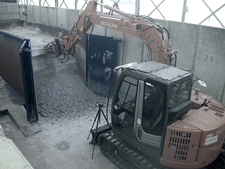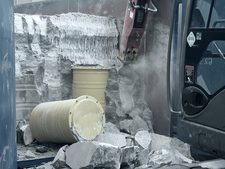Machinery for the recovery of waste
- World-wide, neither experiences nor examples do exist for the recovery of radioactive wastes from a mine requiring remediation.
- First market research, studies and tests examine how drums containing wastes can be liberated from salt rock, part of which is hard as concrete.
- The aim is to develop in the end a list of machinery that can be developed further in order to finally comply with the requirements under nuclear and mining law.
World-wide, neither experiences nor examples do exist for the recovery of radioactive wastes from a mine requiring remediation. Accordingly, no equipment and machinery can be found on the market that has been designed specifically for the requirements of the Asse mine. The BfS has commissioned the Karlsruhe Institute of Technology with first research and studies to determine the exact status and the development needs. Engineers examined
- in the context of a market research, what equipment and machinery is available at all and could be suitable for further development;
- in first trials, how the equipment and machinery can be used;
- after initial experiences and research, what criteria need to be developed for a further evaluation;
- to what extent special procedures from tunnel construction, such as shield tunnelling, might be suitable for the recovery.

![]() Testing of recovery technology in a test set-up
Source: Karlsruhe Institute for Technology (KIT)
Testing of recovery technology in a test set-up
Source: Karlsruhe Institute for Technology (KIT)
In particular experts in the fields of tunnel construction and mining as well as manufacturers of general construction machinery did some initial research. The aim was to examine what technical equipment and machinery is available on the market at all and what could be taken into account for the recovery of the Asse wastes. The experts came to the following conclusion: "Basically, it can be stated that currently standard tools and machinery are available that appear to be suitable for meeting the requirements within the four points of the procedural chain
" (1st interim report, page 88).
The procedural chain describes the individual procedures and work steps to be taken into account during retrieval. These include:
- loosening and uncovering the waste containers or, respectively, container parts from the salt,
- gripping and lifting the containers/container parts,
- placing the containers/container parts in safe transport casks, and
- carting away the transport casks.

![]() Testing of recovery technology in a test set-up
Source: Karlsruhe Institute for Technology (KIT)
Testing of recovery technology in a test set-up
Source: Karlsruhe Institute for Technology (KIT)
First preliminary tests with tools
In order to seal cavities between the waste containers, part of the emplacement rooms was backfilled with salt in the 1960s and 1970s. Therefore, experts assume that part of the drums containing radioactive wastes are firmly enclosed in compressed salt. Part of the drums will have to be loosened from the salt, which is as hard as concrete, with the help of heavy tools.
Under artificially generated conditions, the scientists tested market-standard tools for their usability. For this purpose, they pumped salt concrete into a container filled with metal drums. With the help of special chisels and milling machines, one succeeded to loosen the containers from the hard material.
Procedure from tunnel construction: Shield tunnelling
Shield tunnelling is a procedure used in tunnel construction. It means working under the protection of a steel cylinder open to either side, the shield. The principle: At the front the machine drills and mines, at the back it supports and safeguards. The procedure is mainly suitable for instable or water-carrying rock layers and could also be used for the recovery of the Asse wastes. The shield does not only protect from falling rocks but also enables working under radiation protection conditions. This has also been tested by the Karlsruhe Institute on behalf of the BfS.
The report shows the technical options. "Shield tunnelling may contribute […] to ensuring safety during retrieval in particular in the case of instable mine conditions
,” the experts conclude. "Furthermore, the shield machine clearly provides shielding by classifying restricted areas and control areas.
"
Current status and outlook
Meanwhile, a first evaluation of the equipment and tools available on the market has been made with the first interim reports. Among others, radiation protection aspects and incident risk issues are key in the evaluation. The aim is to develop in the end a list of machinery that can be developed further in order to finally comply with the requirements under nuclear and mining law.

